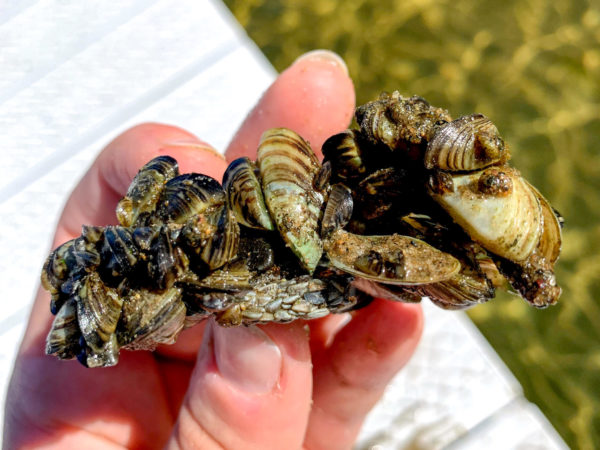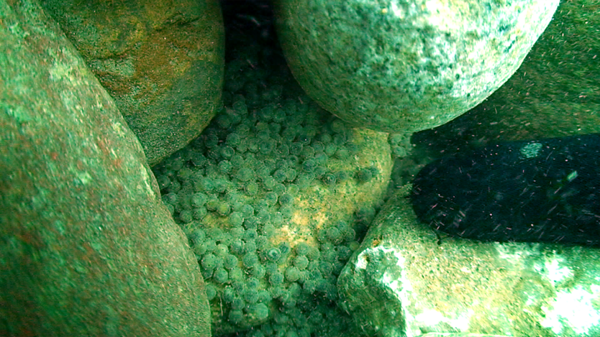
Great Lakes Moment is a monthly column written by Great Lakes Now Contributor John Hartig. Publishing the author’s views and assertions does not represent endorsement by Great Lakes Now or Detroit PBS.
From a distance, I caught a glimpse of a relatively small elongated furry animal moving along the shoreline of the Detroit River. What caught my eye was its bounding gate. A bound is when the animal pushes off its hind feet and does a short leap landing on its front feet. When it was not bounding, this inquisitive animal kept its nose to the ground, poking it into crevices, under boulders, and down any hole it found — apparently looking for food.
As it got closer to me, I was treated with a surprise. It was a mink! Yes, the mammal best known for its fur, including mink coats.
Mink are semiaquatic predators that hunt in and around rivers, catching prey that other predators cannot easily catch. They are often described as the cutest member of the weasel family. But do not let their looks fool you. Mink are voracious predators well known for taking down prey larger than themselves, including muskrats, rabbits, snakes, frogs, fish, and even birds.
Mink are excellent swimmers with partially webbed feet that help them paddle through water and dive underwater to explore nooks and crannies. You often see them alone because they are solitary, except during the mating season in spring. Scientists call mink a keystone species because their predatory behavior can have a big impact on their ecosystems. For example, mink are adept at hunting muskrats. This, in turn, can help regulate muskrat populations and help balance marsh ecology. For example, when their populations get too high, the muskrats eat so much vegetation that the marsh changes and provides fewer benefits to other species.
Difficulty in monitoring mink trends
We do not know much about how Great Lakes mink populations have changed over time because no reliable long-term trend data exist. Trapping data are often not reliable in estimating population size because trapping effort is often limited in scope, resulting in a high proportion of the population not being accessed by trappers using traditional access roads. Further, mink are difficult to trap as they are nocturnal and solitary. Despite these limitations, natural resource managers still keep track of trapping trends to aid in management.
“Based on statewide mink trapping data collected by the Michigan Department of Natural Resources from 1986-2020, it appears that mink harvest has been relatively stable over this period,” said D. Cody Norton. Norton is the bear, furbearer, and small game specialist with the Michigan Department of Natural Resources.
Contaminant stressors
However, we do know a fair amount about threats to mink survival, particularly contaminant stressors that can negatively impact their health. Mink sit at the top of the top of the aquatic food web and therefore accumulate many chemical compounds and heavy metals in their tissue, including polychlorinated biphenyls (PCBs), dioxins — another persistent toxic organic compound — and mercury. This is through a process of biomagnification. Biomagnification is the cumulative increase in the concentration of persistent toxic substances in successively higher levels of the food web — from algae to zooplankton, from zooplankton to fish, from fish to birds, from birds to other larger mammals.

Graphic courtesy of MDHHS
Mink have a storied past because of this biomagnification of contaminants which threatens their survival. In the 1970s, mink were first discovered to be extremely sensitive to environmental contaminants. Following die-offs in the commercial mink ranching operations in the 1980s, laboratory experiments showed that environmental contaminants were the likely cause.
Some of these contaminants are pesticides, like DDT and toxaphene, that have been banned. Some were other human-made chemicals, like PCBs that were used as coolants and lubricants in electrical equipment and in paints, plastics, inks, and more. The element mercury was a byproduct of the production of chlorine and caustic soda and was used in thermometers and dental fillings.
During the 1980s and 1990s, research studies found that a mink diet made up of as little as 20-40% fish contaminated with toxic substances, would result in reproductive problems. In the 1990s, scientists reported that mink populations had declined in many areas of the world. These declines were linked to exposures to the environmental contaminants identified above. These scientists went on to report that mink were fewer in areas along the shores of the Great Lakes and their tributaries where mink had access to contaminated fish from the Great Lakes.
Limitations of using mink as a sentinel species
Sentinel species are organisms, often animals, used to detect risks to ecosystem health by providing advance warning of danger. Mink have long been considered a sentinel of environmental contamination.

Graphic courtesy of MDHHS
However, mink do not always satisfy an important criterion of being a good sentinel species. To be a good sentinel species for environmental contamination it should be a lifetime resident of the ecosystem being monitored. Researchers found out that domestic mink commonly escape from mink farms, biasing any mink sampling to assess environmental health. Furthermore, escaped domestic mink may mate with wild mink, leading to domestic–wild hybrids.
The bottom line is that domestic mink and domestic-wild hybrids could well have contaminant burdens that reflect farm environments rather than natural ecosystems, leading to biased estimates of ecosystem health. Therefore, researchers recommend that steps be taken to exclude domestic mink from free-ranging mink samples in studies of environmental health.
Indirect evidence of reduced contaminant stressors
Although mink are often nocturnal and can be reclusive, they are regularly seen in and along the Detroit River. This is good news, but does not provide evidence of a population revival.
There is, however, indirect evidence of reduced contaminant stressors that can negatively impact the health of aquatic animals, like mink. For example, mercury concentrations in Lake St. Clair walleye have decreased by more than 80% since 1970. Detroit River and Lake St. Clair share the same fish community so similar decreases would likely be found in Detroit River walleye.
PCB concentrations in herring gull eggs from Fighting Island in the Detroit River have decreased by 90% since 1978. Finally, PCB concentrations in snapping turtles in the Detroit River have decreased, with good hatching success and no deformities. Based on this weight of evidence, it can be concluded that there have likely been decreases in contaminant stressors affecting mink in the Detroit River.
Mink status
“A good way of thinking about mink survival requirements in the Detroit River is as a three-legged stool — they need adequate habitat, sufficient prey as food, and safe food that is not contaminated with toxic substances,” said Dr. Lisa Williams, ecotoxicologist specializing in contaminant impacts in the Great Lakes. “All three requirements must be met for mink to flourish.”
There is no doubt that there have been improvements in Detroit River ecosystem health that are helping meet mink survival requirements. For example, many habitat rehabilitation and enhancement projects have been completed in the Detroit River, meaning that food availability is relatively high, and, as noted above, there have been reductions in contaminant exposure.
“Mink are now a fairly common sighting along the shoreline of the Detroit River and its islands, and in Pointe Mouillee State Game Area,” said Joe Robison, southeast regional supervisor for the Michigan Department of Natural Resources. “We believe that diminished contaminant exposure, habitat enhancements, and fewer trappers are contributing to a thriving population.”
So, the next time you are on or along the Detroit River, keep an eye peeled for a mink and reflect on how they are thriving in this once-polluted river.
John Hartig is a board member at the Detroit Riverfront Conservancy. He serves as a Visiting Scholar at the University of Windsor’s Great Lakes Institute for Environmental Research and has written numerous books and publications on the environment and the Great Lakes. Hartig also helped create the Detroit River International Wildlife Refuge, where he worked for 14 years as the refuge manager.
Catch more news at Great Lakes Now:
Great Lakes Moment: Ten natural wonders of The Great Lakes Way
Operation Manoomin: Restoring Wild Rice along the Detroit River
Featured image: A mink along the Grosse Ile shoreline of the Detroit River. (Photo Credit: Marty Taylor)




